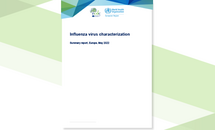Influenza virus characterisation - Summary Europe, December 2021
This is the third report for the 2021-2022 influenza season. As of week 52/2021, 23 246 influenza detections across the WHO European Region were reported to TESSy, a rise of over 20 000 since week 47/2021, with most being reported from week 49/2021 onwards. Of these 23 246 detections, 96% were type A viruses, with A(H3N2) (96%) dominating over A(H1N1)pdm09 (4%), and 4% type B with only 13 having been ascribed to a lineage, one of which was B/Yamagata. This represents a large increase (22 831, 5 601%) in detections compared to the 2020-2021 season, on the back of a large increase (670 166, 438%) in the number of samples tested, and is closer to the more usual number of detections seen at this time in earlier seasons. The increased testing is probably related to the emergence of SARS-CoV-2 and measures introduced to combat it.
Executive Summary
Since the November 2021 characterisation report, 12 shipments from EU/EEA countries were received at the London WHO Collaborating Centre, the Francis Crick Worldwide Influenza Centre (WIC) and the great majority of samples therein have yet to be fully characterised. This report therefore focuses on genetic characterisation of HA genes of representative seasonal influenza viruses submitted and/or released in GISAID during December 2021, with a focus on those viruses with collection dates after 31 August 2021, together with sequences recently determined at the WIC. The genetic clade nomenclature system adopted during the September 2021 vaccine composition meeting VCM is used throughout the document. The data show increased levels of influenza detections globally with a maintained predominance of A(H3N2) viruses.
Very low numbers of A(H1N1)pdm09 detections have been reported. Of 11 viruses with collection dates after 31 August 2021, three fell in the 6B.1A.5a.1 subgroup, represented by the vaccine virus for the northern hemisphere 2020/2021 season, A/Guangdong Maonan/SWL1536/2019 60 and eight fell in the 6B.1A.5a.2 subgroup, represented by A/Victoria/2570 like an d A/Wisconsin/588/2019-like viruses which have been recommended respectively for egg- and cell-based vaccines in the 2021/2022 northern and 2022 southern hemisphere influenza seasons, but with additional HA amino acid substitutions seen previously in viruses from India A single 6B.1A.5a.2 virus with these additional substitutions, A/Denmark/18/2021, showed a fourfold reduction in HI titre compared to the homologous titre with post-infection ferret antiserum raised against IVR 215 (A/Victoria/2570/2019) vaccine virus.
The vast majority of recently detected A(H3N2) viruses have fallen in subgroup 3C.2a1b.2a and been ‘Bangladesh-like’ (3C.2a1b.2a.2), with many EU/EEA countries reporting detections. A/Cambodia/e0826360/2020-like (3C.2a1b.2a.1) viruses were recommended for use in the 2021-2022 northern hemisphere season, while A/Darwin/9/2021-like and A/Darwin/6/2021-like (3C.2a1b.2a.2) viruses were recommended for egg- and cell-based vaccines in the 2022 southern hemisphere season. Six 3C.2a1b.2a.2 viruses isolated in Denmark all showed good recognition by post- infection ferret antisera raised against representative 3C.2a1b.2a.2 viruses, but only one, with rare HA1 I140K and R201I amino acid substitutions showed good reactivity with antisera raised against 3C.2a1b.2a.1 viruses.
While all B/Victoria-lineage HA gene sequences derived from viruses collected after 31 January 2021 have lost encoding of a three amino acid triplet (HA1 residues 162-164) and fall in subclade V.1A.3 represented by B/Washington/02/2019, the vaccine virus recommended for inclusion in influenza vaccines for the 2021-2022 northern hemisphere season, such viruses have been detected only in Kenya and the United States (US) recently. The great majority of sequences from recently detected viruses, in geographically dispersed countries, have fallen in the V1A.3a group defined by a series of HA1 amino acid substitutions including N150K with most falling in the V1A.3a.2 subgroup with defining HA1 A127T, P144L and K203R amino acid substitutions. B/Austria/1359417/2021-like (V.1A.3a.2) viruses have been recommended for use in the southern hemisphere 2022 influenza season. Antigenically, viruses in subgroups of the V.1A.3a group differ and show some loss of reactivity with post-infection ferret antisera raised against B/Washington/02/2019. A single V.1A.3a.2 virus, B/Netherlands/10007/2021, showed good recognition by post-infection ferret antisera raised against B/Austria/1359417/2021, but poor recognition by an antiserum raised against B/Washington/02/2019.
No B/Yamagata-lineage HA sequences from clinical specimens collected in 2021, and none with collection dates after March 2020, were available. All sequences from the 77 viruses detected in 2020, inclusive of 12 from EU/EEA countries, belong to genetic clade Y3 and carry three HA1 amino acid substitutions (L172Q, D229N and M251V) compared to B/Phuket/3073/2013-like viruses which have been recommended for use in quadrivalent influenza vaccines for the 2021-2022 northern hemisphere and 2022 southern hemisphere seasons. The antigenic effects of these amino acid substitutions have been minimal as assessed in earlier reports.
Download








